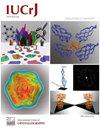Crystal structure of a bacterial photoactivated adenylate cyclase determined by serial femtosecond and serial synchrotron crystallography
IF 3.6
2区 材料科学
Q2 CHEMISTRY, MULTIDISCIPLINARY
引用次数: 0
Abstract
Structures of the dark-adapted state of a photoactivated adenylate cyclase were determined from serial crystallography (SX) data collected at room temperature at an X-ray free-electron laser and a synchrotron, and are compared with cryo-macromolecular crystallography (MX) synchrotron structures obtained by us and others. These structures of the wild-type enzyme in combination with the cryo-MX synchrotron structure of a light-sensor domain mutant provide insight into the hydrogen-bond network rearrangement upon blue-light illumination and pave the way for the determination of structural intermediates of the enzyme by time-resolved SX.
OaPAC is a recently discovered blue-light-using flavin adenosine dinucleotide (BLUF) photoactivated adenylate cyclase from the cyanobacterium Oscillatoria acuminata that uses adenosine triphosphate and translates the light signal into the production of cyclic adenosine monophosphate. Here, we report crystal structures of the enzyme in the absence of its natural substrate determined from room-temperature serial crystallography data collected at both an X-ray free-electron laser and a synchrotron, and we compare these structures with cryo-macromolecular crystallography structures obtained at a synchrotron by us and others. These results reveal slight differences in the structure of the enzyme due to data collection at different temperatures and X-ray sources. We further investigate the effect of the Y6W mutation in the BLUF domain, a mutation which results in a rearrangement of the hydrogen-bond network around the flavin and a notable rotation of the side chain of the critical Gln48 residue. These studies pave the way for picosecond–millisecond time-resolved serial crystallography experiments at X-ray free-electron lasers and synchrotrons in order to determine the early structural intermediates and correlate them with the well studied picosecond–millisecond spectroscopic intermediates.
通过串行飞秒和串行同步辐射晶体学测定的细菌光激活腺苷酸环化酶晶体结构。
OaPAC 是最近发现的一种利用蓝光的黄素腺苷二核苷酸(BLUF)光活化腺苷酸环化酶,它来自蓝藻 Oscillatoria acuminata,利用三磷酸腺苷并将光信号转化为环状单磷酸腺苷的产生。在此,我们报告了该酶在无天然底物情况下的晶体结构,这些晶体结构是根据在 X 射线自由电子激光器和同步加速器上收集的室温序列晶体学数据确定的,我们还将这些结构与我们和其他人在同步加速器上获得的低温大分子晶体学结构进行了比较。这些结果表明,由于在不同温度和 X 射线源下采集的数据不同,酶的结构也略有差异。我们进一步研究了 BLUF 结构域中 Y6W 突变的影响,该突变导致黄素周围氢键网络的重新排列以及关键 Gln48 残基侧链的显著旋转。这些研究为在 X 射线自由电子激光器和同步加速器上进行皮秒-毫微秒时间分辨序列晶体学实验铺平了道路,以便确定早期的结构中间产物,并将它们与研究得很好的皮秒-毫微秒光谱中间产物联系起来。
本文章由计算机程序翻译,如有差异,请以英文原文为准。
求助全文
约1分钟内获得全文
求助全文
来源期刊

IUCrJ
CHEMISTRY, MULTIDISCIPLINARYCRYSTALLOGRAPH-CRYSTALLOGRAPHY
CiteScore
7.50
自引率
5.10%
发文量
95
审稿时长
10 weeks
期刊介绍:
IUCrJ is a new fully open-access peer-reviewed journal from the International Union of Crystallography (IUCr).
The journal will publish high-profile articles on all aspects of the sciences and technologies supported by the IUCr via its commissions, including emerging fields where structural results underpin the science reported in the article. Our aim is to make IUCrJ the natural home for high-quality structural science results. Chemists, biologists, physicists and material scientists will be actively encouraged to report their structural studies in IUCrJ.
 求助内容:
求助内容: 应助结果提醒方式:
应助结果提醒方式:


